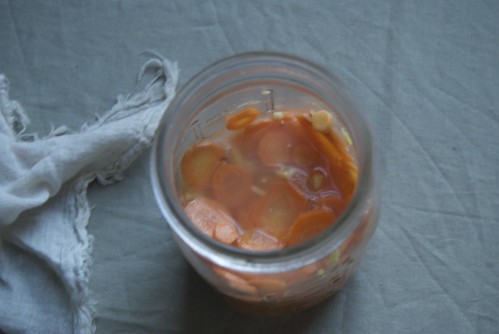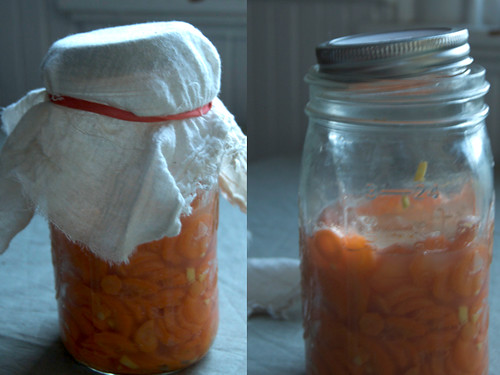Fermentation involves creating the right environment for living organisms to transform ordinary vegetables or grains into something that is alive and more nutritious. These living organisms are already there ready to make this transformation, they just need the right ingredients and environment to thrive. It is easy to facilitate this change from an ordinary vegetable to a fermented one. With its unique flavor and softer texture, a fermented vegetable is easier for us to digest and beneficial to our health.
Last year I made Red Sauerkraut. I made a batch of it this fall, too, but I think I left it on the counter a little too long. I've got apple cider vinegar in process and just moved the pickled daikon from the counter to the fridge. Oddly, daikon was one of the first fermented foods that I ate regularly when I used to buy it from a natural foods store. We had a lot of these giant radishes growing at the farm and I didn't know what else to do with them so I made fermented pickles. Once the daikon was ready, I cut up some carrots which are now fermenting in a jar with ginger and, of course, salt. I admit that I love the process of fermenting, but frequently forget to eat the results. I am trying to add a little side of fermented vegetables to a meal every day.
It may be a bit of stretch, but fermentation reminds me that it just takes the right ingredients or environment to change something for the better. As I have more time to work on projects and dream even more vividly of making my living creatively, I often struggle to find a balance between pushing myself to work hard and knowing when to let go. I know that it takes work to achieve big goals but I'd like to think that we've all got what it takes to live our dreams. We just need to find the right ingredients, environment, and process to get there.
Pickled Daikon
Pickling the daikon makes for a mild flavored slightly crunch radish. I don't use daikon a lot otherwise, but I enjoy the way it tastes when fermented. Fermenting also helps vegetables to last longer and can be kept in the fridge for a few months. I always think it is amazing the way the salt draws enough water from the vegetable to create a brine. If your daikon is less fresh, you might need to add a little more water and salt to cover it. Sometimes a bit of white mold may bloom on the surface during the fermenting process. This doesn't usually happen when fermenting in glass jars, but if it does, just scrape it off. If you have no interest in daikon or don't know where you can get it, I've included a recipe for fermented carrots and ginger below.
1 pound daikon radish
1 teaspoon salt
Slice the daikon into thin rounds and place in a bowl. Add the salt and mix well. Pack the daikon into a clean wide mouth quart jar, pressing down on it to force the water out. Once the daikon is solidly packed in the jar fill a clean half pint jar with water and screw the lid on tightly. The small jar should fit in the opening of the quart jar and rest on top of the daikon to keep it under water (see photos above). Use cheese cloth and a rubber band to let air in but keep flies out. For the first 24 hours, check it frequently and continue pressing on the daikon to push the water out. If water has not covered the daikon within a day add enough water and a little salt to cover the vegetable.
Keep the jar somewhere out of the way, but where you won't forget about it. Depending on the temperature, it will take about a week to ferment. Check it frequently, smelling or tasting it until it has reached the tangy taste that you like. When it is ready, store in an airtight jar in the fridge.
Fermented Carrots with Ginger
Adapted from Nourishing Traditions by Sally Fallon
2 cups of carrots, sliced into thin rounds
1 tablespoon ginger, finely chopped
2 teaspoons salt
Mix the ingredients together and follow the process above for packing into a jar and fermenting.




great post, thanks for sharing.
ReplyDeletePHL Airport Taxi
Great blog you have herre
ReplyDelete